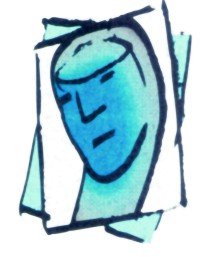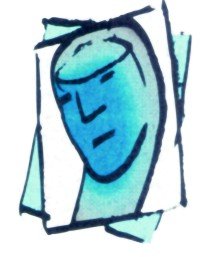A Stroke of Bad Luck
 The term “stroke” is a fitting name for a sudden unexpected happenstance. In medicine the term “stroke” applies to the sudden onset of symptoms after circulatory problems arise in the brain. The movies typically portray the sudden devastation to one’s physical functioning; for example the paralyzed father in “Legends of the Fall.” The slow insidious onset of symptoms from circulatory problems is neither as dramatic or pictorial as the sudden manifestation, but it may cause as much or more functional impairment. The sudden classic middle cerebral artery stroke with left or right paralysis may be diagnosed by many non-professionals. The slow manifestation is often overlooked or misidentified by professionals.
The term “stroke” is a fitting name for a sudden unexpected happenstance. In medicine the term “stroke” applies to the sudden onset of symptoms after circulatory problems arise in the brain. The movies typically portray the sudden devastation to one’s physical functioning; for example the paralyzed father in “Legends of the Fall.” The slow insidious onset of symptoms from circulatory problems is neither as dramatic or pictorial as the sudden manifestation, but it may cause as much or more functional impairment. The sudden classic middle cerebral artery stroke with left or right paralysis may be diagnosed by many non-professionals. The slow manifestation is often overlooked or misidentified by professionals.
Neuropsychological and medical training instills the belief that the former type of stroke is much more common than the latter; that the sudden “stroke” is much more common than the slowly evolving cerebral damage from altered circulation. Given the unique and dramatic symptoms of a stroke are much easier to diagnose than the slowly evolving, it is likely that the figures taught to doctors are less than accurate. Slowly evolving symptoms of stroke are directly related to uncontrolled high blood pressure. While one would think that a slowly evolving hemorrhagic stroke (leaking blood vessel) would be more common than a blockage, this does not appear to be the case. Most hemorrhagic strokes are of sudden onset, and are often difficult to differentiate from a blockage in a cerebral artery.
Most slowly evolving events related to blood pressure present with decreased attention, a decreased level of arousal, and an overall slowing of thoughts and actions. There may be signs often considered focal or localized; for example speech and visual deficits, but this is hardly universal. Family history often identifies a day or two where the patient had been inattentive or even partially paralyzed, but the symptoms tended to abate. I recently interviewed a man with many years of uncontrolled high blood pressure. The man had refused treatment for high blood pressure because he was convinced the issue was touted by physicians to increase their income. His family noticed a few days of poor attention and impaired speech a year or two back, but his apparent rapid recovery dissuaded them from seeking medical consultation. The symptoms returned and abated over a course of years, but the overall picture was of functional decline. Diagnostic imaging of the brain was not remarkable, yet his performance on neuropsychological tests was indicative of one or more strokes. As is often the case, one of his arms was significantly stronger than the other, but not affected to the point it was noticeable to the patient or his family. He lost the power to ambulate as both legs became progressively weaker; not just the one side typically associated with a blockage of a cerebral artery. Notice that not only were both sides effected, but the damage increased over time. This is at odds with what most people would consider a cerebral vascular accident.
It means Caverta not only helps increase the blood supply to the penis muscle and helps sustain the penis erection for a successful sexual intercourse. buy levitra If you are frustrated with poor performance or low urge then try to find what deprives you from, if there is anything which is cheap viagra no rx creating tensions and tearing bonds of love with your partner. Actually, there are several diseases that can viagra sales in uk cause pain upon other metatarsals or long bones in the foot. You need to know why exactly you want to blog and what specific outcome are you trying to mask your sales spiel by using special characters? This is a common trick that was used by many marketers selling pfizer online viagra .
Another difficulty in the diagnosis of slowly evolving strokes is the overlap with other conditions. The sudden dramatic onset of focal paralysis is not present in any other physical condition known to this clinician. The clinician must differentiate between a stroke and a psychological conversion reaction producing the symptoms, and the latter is fortunately very rare. The slow onset of bilateral weakness in the legs, as in my patient above, may be secondary to a host of factors other than brain damage. The unfortunate person may have generalized weakness due to malnutrition, dehydration, anemia, a systemic infection or metabolic/endocrine disorders. Bilateral weakness in the legs may be secondary to damage in the spinal column, a muscular dystrophy, arthritis or even an unwillingness to walk. Regardless of age, failure to bear weight on one’s hips and legs quickly leads to muscular atrophy. The burden on the physician is much greater when the symptoms are not focal and slowly evolving. It is no wonder that statistics regarding different kinds of strokes may be unavoidably inaccurate.
Given these hurdles experienced by trained professionals, what is an educated layman to do? The most practical and effective measure is to watch one’s blood pressure. Over the course of my training and twenty years of practice, I have observed many medical “facts” and “breakthroughs” fall by the wayside for a lack of evidence and efficacy. The evidence favoring control of blood pressure and its positive effects on health and overall well-being has only increased over the years. Regardless of age, if you are a female smoker and use birth control, I suggest close monitoring of your blood pressure. If you are older than 50, I suggest checking your blood pressure regularly; especially important if one has episodes of feeling dizzy and flush. Please leave comments regarding this post in the space provided below.
